High Impact Tutoring Built By Math Experts
Personalized standards-aligned one-on-one math tutoring for schools and districts
In order to access this I need to be confident with:
Parts of a circle Pythagorean Theorem Congruent shapes Angles of a triangle Quadrilateral angles Types of quadrilaterals Right triangles Isosceles triangles Supplementary anglesCircle theorems
Here you will learn about circle theorems, including their application, proof, and how to use them to problem solve. You will learn how these theorems apply to angles formed by secant and tangent lines and how they apply to properties within a circle.
Students first learn about circle theorems in geometry where they learn how to apply the theorems to problem solve. Students use the concepts taught in precalculus and calculus as well as on standardized tests such as SATs and state assessments.
What are circle theorems?
Circle theorems verify properties that show relationships between angles formed by special lines and line segments and arcs within a circle. These theorems along with prior knowledge of other angle properties are used together to problem solve.
Let’s take a look in greater depth at the following:
- Central angles
- Chords of a circle
- Circle and chord theorems
- Subtended angles
- Tangents of a circle
Below is a summary of each theorem, along with a diagram. You need to remember all of these circle theorems and be able to describe each one in a sentence.
![[FREE] Common Core Practice Tests (Grades 3 to 8)](https://thirdspacelearning.com/wp-content/uploads/2023/10/Common-Core-Practice-Test-Grade-3-8-OG-Image.png)
[FREE] Common Core Practice Tests (Grades 3 to 8)
![[FREE] Common Core Practice Tests (Grades 3 to 8)](https://thirdspacelearning.com/wp-content/uploads/2023/10/Common-Core-Practice-Test-Grade-3-8-OG-Image.png)
Prepare for math tests in your state with these Grade 3 to Grade 8 practice assessments for Common Core and state equivalents. 40 multiple choice questions and detailed answers to support test prep, created by US math experts covering a range of topics!
DOWNLOAD FREE![[FREE] Common Core Practice Tests (Grades 3 to 8)](https://thirdspacelearning.com/wp-content/uploads/2023/10/Common-Core-Practice-Test-Grade-3-8-OG-Image.png)
[FREE] Common Core Practice Tests (Grades 3 to 8)
![[FREE] Common Core Practice Tests (Grades 3 to 8)](https://thirdspacelearning.com/wp-content/uploads/2023/10/Common-Core-Practice-Test-Grade-3-8-OG-Image.png)
Prepare for math tests in your state with these Grade 3 to Grade 8 practice assessments for Common Core and state equivalents. 40 multiple choice questions and detailed answers to support test prep, created by US math experts covering a range of topics!
DOWNLOAD FREECentral angles
Central angles are angles that have a vertex at the center of the circle and the sides of the angle are the radii of the circle.
Angle ABC is a central angle of circle B.
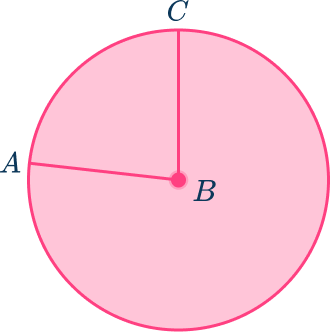
The degree measurement of a central angle is equal to the arc it intercepts.
Angle ABC=60^{\circ} and arc AC=60^{\circ}
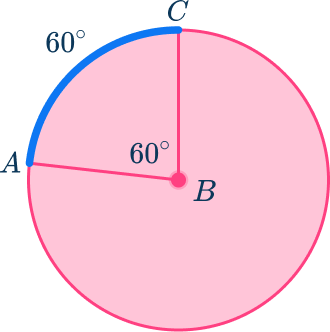
Inscribed angles are angles that have a vertex on the edge of the circle and the sides are chords of the circle. The measurement of the inscribed angle is \cfrac{1}{2} the measurement of the arc it intercepts.
Angle CEA is an inscribed angle (subtended angle) and the measurement of this inscribed angle is 30^{\circ} because it intercepts an arc that is 60^{\circ}.
The inscribed angle is always \cfrac{1}{2} the measurement of the arc it intercepts.
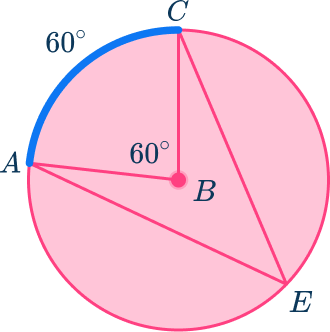
Remember: A subtended angle is an angle inside a circle that is created by two chords that meet at a point on the circle.
Step-by-step guide: Central Angle
Chords of a circle
Chords are line segments inside a circle that have endpoints on the edge of the circle. The longest chord in a circle is the diameter. Chords create situations within a circle that can help us to solve problems.
- Chords that are congruent intercept congruent arcs. Chord HG and Chord KJ are congruent. So, the arcs they intercept are congruent, Arc HG is congruent to Arc KJ.
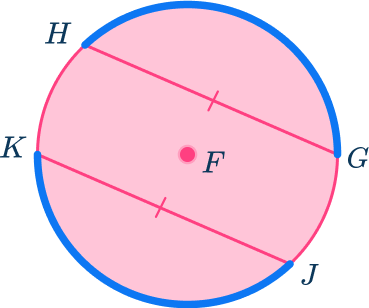
- When the diameter (or radius) is perpendicular to a chord, it also bisects (cuts in half) the chord. Diameter DK in circle C is perpendicular to chord GH, therefore, DK also bisects GH, \, JH \approx GJ.
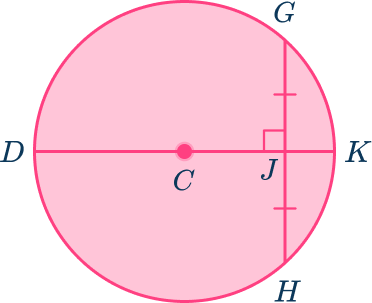
- In a circle or congruent circles, two chords are congruent if and only if they are equidistant (the same distance) from the center of the circle.
In circle B, you can determine that chord LM and chord NQ are congruent if you know that they are the same distance (perpendicular distance) from point B.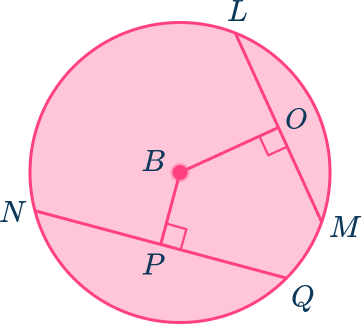
If BO is perpendicular to LM and if BP is perpendicular to NQ and BO is congruent in length to BP, you can conclude that LM is congruent to NQ.
Step-by-step guide: Chords of a circle
Step-by-step guide: Circle chord theorems
Subtended angles
Subtended angles of a circle form inscribed angles. When inscribed angles intercept the same arc they are congruent.
Angle KGM, angle KEM and angle KLM all intercept the same arc, arc KM. If arc KM is 60^{\circ}, then angle KGM=30^{\circ}, angle KEM=30^{\circ} and angle KLM=30^{\circ}.
So, \text{ angle } KGM \approx \text { angle } KEM \approx \text{ angle } KLM.
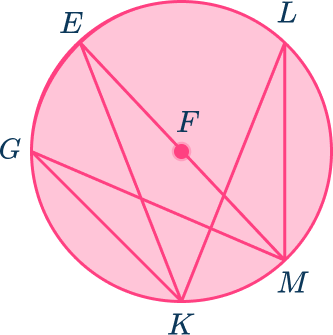
Subtended angles can form inscribed quadrilaterals and triangles.
A quadrilateral can be inscribed in a circle, meaning that all four vertices are on the edge of the circle, if the opposite angles of a quadrilateral are supplementary (sum to 180^{\circ} ).
Inscribed quadrilaterals are also called cyclic quadrilaterals.
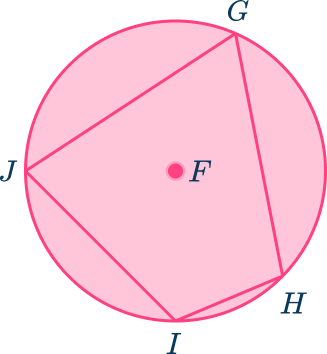
Quadrilateral HIJG is inscribed in circle F , so opposite angles must be supplementary.
\text{ angle } J + \text{ angle } H=180^{\circ} \text{ angle } I + \text{ angle } G=180^{\circ}Inscribed triangle ABC has one side as the diameter of the circle D.
Triangle ABC is a right triangle because the intercepted arc of angle A is semi-circle CB which is 180^{\circ}.
The measure of the intercepted arc is half the measure of the arc it intercepts, so in this case, angle A=90^{\circ}
This is also known as the semicircle theorem.
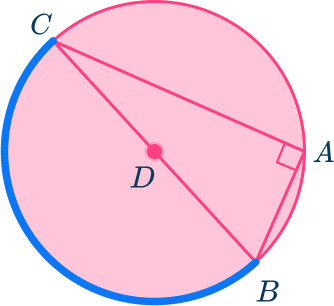
Step-by-step guide: Subtended angles
Tangents of a circle
Tangent lines are lines that touch the circle at one point called the point of tangency.
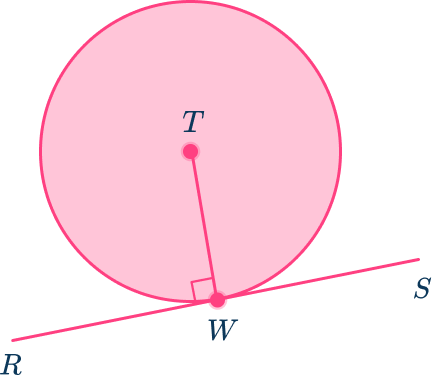
Line RS is tangent to circle T if and only if the line is perpendicular to the radius at point W. Point W is the point of tangency.
If two lines are tangent to a circle from an external point, the tangent lines will be congruent in length. The tangent line must be perpendicular to the radius at the point of tangency, so using congruent triangles, you can prove that the tangent lines are congruent.
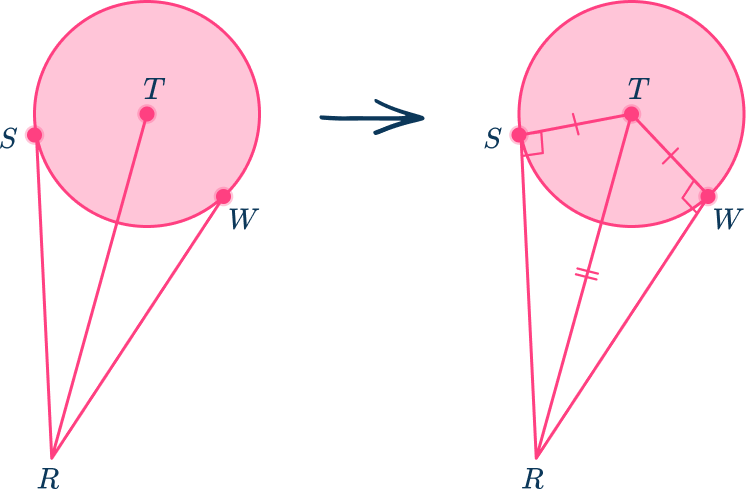
Through HL (Hypotenuse Leg) you can prove that triangle STR is congruent to triangle WTR.
Therefore, by CPTPC (Corresponding parts of congruent triangles are congruent) you can conclude that segment SR is congruent to segment WR, which are the tangent segments.
Step-by-step guide: Tangents of a circle
What are circle theorems?
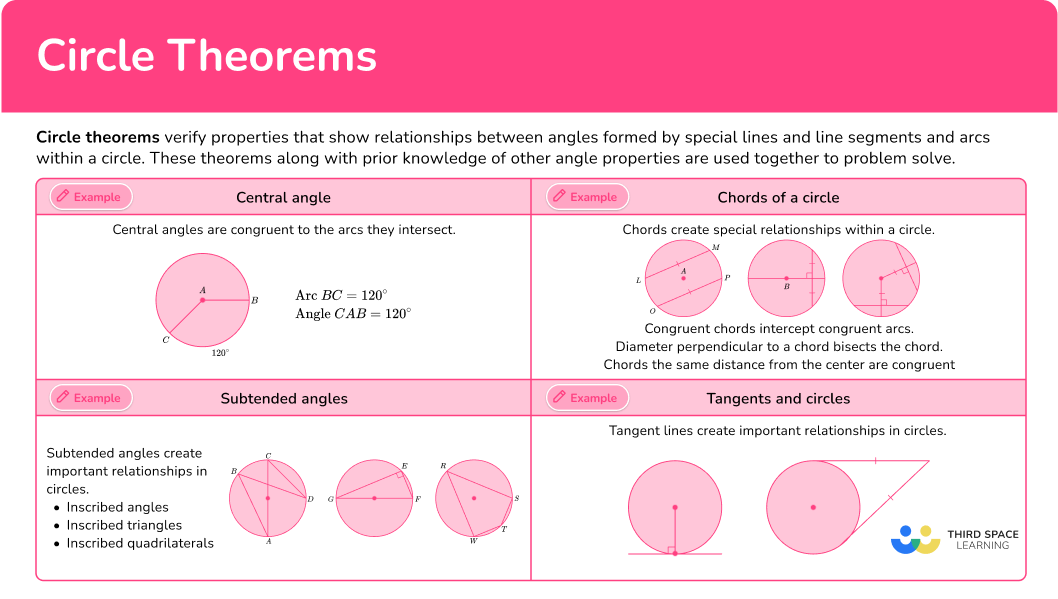
Common Core State Standards
How does this apply to geometry?
- High School Geometry – Circles (HSG-C.A.2)
Identify and describe relationships among inscribed angles, radii, and chords. Include the relationship between central, inscribed, and circumscribed angles; inscribed angles on a diameter are right angles; the radius of a circle is perpendicular to the tangent where the radius intersects the circle.
How to use circle theorems to solve problems
There are several ways to apply circle theorems to problem solve. For more specific step-by-step guides, check out the pages linked in the “What are circle theorems?” section above or read through the examples below.
In order to problem solve using circle theorems:
- Recall the theorem.
- Solve the problem.
Circle theorem examples
Example 1: central angle theorem
Find the measure of angle A in circle D.
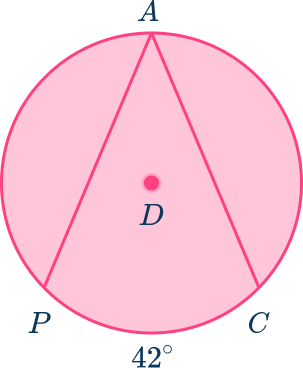
- Recall the theorem.
Angle A is an inscribed angle and is half the measure of the arc it intercepts.
2Solve the problem.
Arc PC is the intercepted arc of angle A. Arc PC=42^{\circ} and angle A is an inscribed angle.
42 \div 2=21Angle A=21^{\circ}
Example 2:
Find the measure of arc WV in circle R.
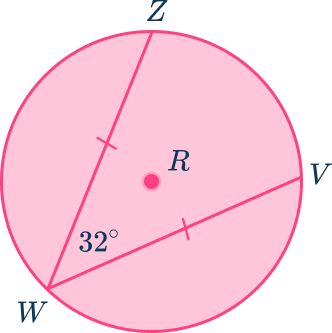
Recall the theorem.
Angle Angle W is an inscribed angle and is half the measure of the arc it intercepts.
Also, chord WV is congruent to chord WZ so the arcs they intercept are also congruent, meaning that arc WV is congruent to arc WZ.
Solve the problem.
Since angle W is 32^{\circ}, arc ZV is double that measurement.
32 \times 2=64
Arc ZV=64^{\circ}
The measurement of a full circle is 360^{\circ}, subtract 64^{\circ} from that, 360-64=296.
That means that the two congruent arcs, arc WZ and arc WV together equal 296^{\circ}.
Since both arcs are congruent, to find the measure of one of them divide 296 in half.
296 \div 2=148, arc WV=148^{\circ}
Example 3:
Find the value of x.
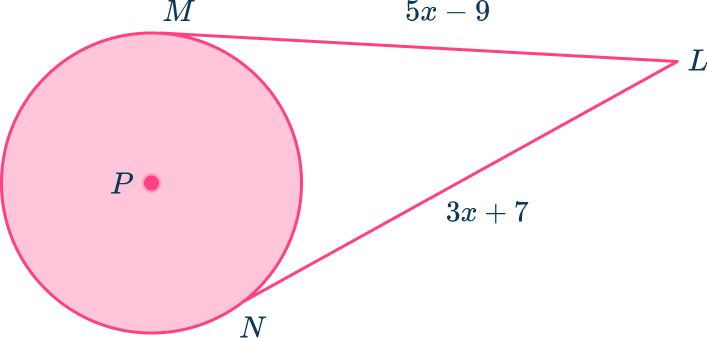
Recall the theorem.
Segment LM and segment LN are tangent segments of circle P. When two lines come from the same external point and are tangent to the same circle, the tangent lines (segments) are congruent. In this case, LM is congruent to LN.
Solve the problem.
Since LN and LM are congruent, they are also equal.
LM=5x-9 and LN=3x+7
LM=LN
\begin{aligned}& 5 x-9=3 x+7 \\\\
& 2 x=16 \\\\
& x=8 \end{aligned}
Example 4:
In circle E, find the value of angle G.
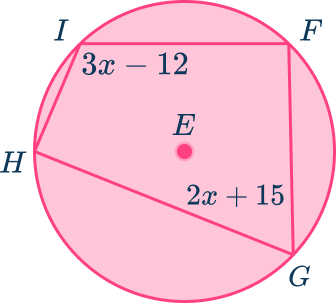
Recall the theorem.
Quadrilateral HIFG is inscribed in circle E. Inscribed quadrilaterals have opposite angles that are supplementary (sum to 180 ). Angle I \, + angle G=180
Solve the problem.
Since angle I \, + angle G=180 and angle I=3x-12 and angle G= 2x+15, you can write and solve the equation:
\begin{aligned}& 3 x-12=2 x+15 \\\\
& x=27 \end{aligned}
Since x=27, substitute that value in for x,
Angle G=2x+15=2(27)+15=69
Angle G=69^{\circ}
Example 5:
Triangle TQR is inscribed in circle P and TQ=QR=10. Find the length of the diameter, TR.
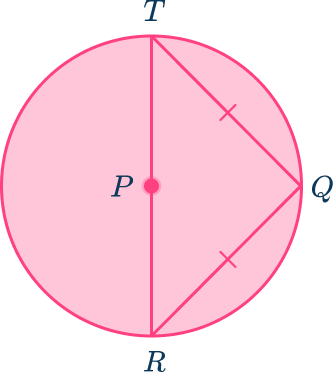
Recall the theorem.
Angle Q is an inscribed angle of circle P and also an angle of the inscribed triangle TQR. The inscribed angle is half the measure of the arc it intercepts and in this case, angle Q intercepts semi-circle TR.
The semi-circle is 180^{\circ} , so angle Q=\cfrac{1}{2} \times 180=90. Angle Q is a right angle, so triangle TQR is an inscribed right triangle.
Solve the problem.
Using the Pythagorean theorem, you can solve for the diameter which is also the hypotenuse of the right triangle.
Pythagorean theorem, a^2+b^2=c^2 where TQ and RQ are a and b.
\begin{aligned}& 10^2+10^2=c^2 \\\\
& 100+100=c^2 \\\\
& 200=c^2 \\\\
& 14.1=c \text { (rounded to } 1 \text { decimal place }) \end{aligned}
The diameter, TR, length is 14.1 units.
Example 6:
In circle C, the diameter is 14 units and JK is 3 units. Find the length of GH.
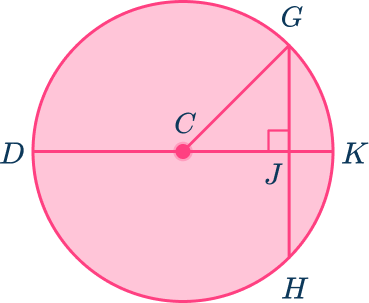
Recall the theorem.
In circle C, since the diameter is 14 units the radius is half of that. So, the radius length is 7 units. The diameter is also perpendicular to GH, so it also bisects GH meaning that it cuts it in half, GJ=JH.
Triangle CJG is a right triangle because the diameter is perpendicular to GH forming a right triangle.
Solve the problem.
Using the fact that CJG is a right triangle, apply the Pythagorean theorem to find the missing side, JG.
CG is the radius of the circle which is 7 units.
CK is also a radius of the circle which is 7 units. If you subtract JK from CK you get the value of CJ (given the information that JK=3 units).
7-3=4
CJ=4 units
Using the Pythagorean theorem, a^2+b^2=c^2 where CJ is a and the radius (CG) is c.
\begin{aligned}& 4^2+b^2=7^2 \\\\
& 16+b^2=49 \\\\
& b^2=33 \\\\
& b \approx 5.7 \text { (rounded to } 1 \text { decimal place) } \end{aligned}
GJ=5.7 which means that JH=5.7 So, GH=5.7+5.7=11.4
GH=11.4
Teaching tips for circle theorems
- Provide opportunity for students to discover the theorems and make conjectures using compasses and protractors.
- Use digital platforms such as Desmos so students can investigate strategies to problem solve using the circle theorems.
- Have students use online platforms such as Khan Academy which contain tutorials created by math tutors to practice exam questions and to prepare for the SAT.
- Although worksheets provide an opportunity for students to practice skills, using digital platforms that focus on gameplay is more effective in engaging students.
Easy mistakes to make
- Doubling instead of halving
Thinking that you should double the intercepted arc measurement to find the measure of the inscribed angle instead of halving it.
For example, thinking that angle CBA is 104^{\circ} instead of 26^{\circ}. Angle CBA=\cfrac{1}{2} \times 52=26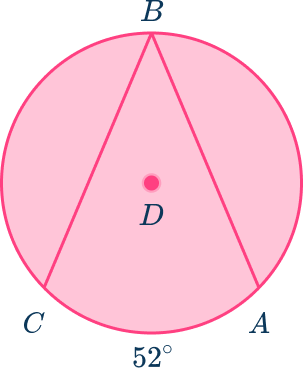
- Thinking that consecutive angles of an inscribed quadrilateral are always supplementary
The opposite angles of an inscribed quadrilateral are always supplementary. The consecutive angles may be supplementary but are not always supplementary like in the figures below.
In both circles, the opposite angles must be supplementary because the quadrilaterals are inscribed so. In circle G, the consecutive angles are also supplementary because quadrilateral ABCD is a square.
- Thinking that any chord that is perpendicular to another chord bisects it
When the diameter is perpendicular to a chord it will always bisect that chord. But not all chords that are perpendicular bisect each other.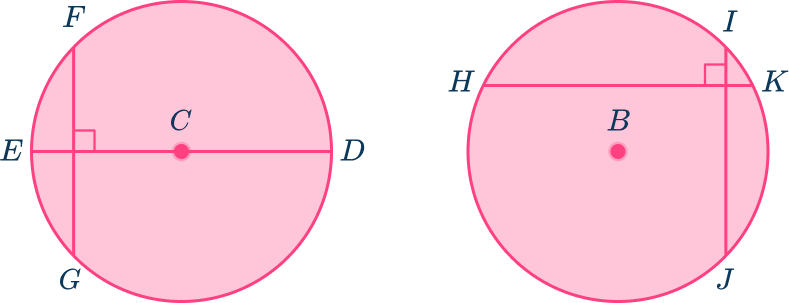
In circle C, \, ED is the diameter which is perpendicular to chord FG. \, FG is also being bisected by ED. In circle B, chords HK and IJ are perpendicular but neither one is being bisected.
- Not using triangles to find missing lengths
For example, in the figure below depending on the given information, it might be helpful to sketch an isosceles triangle because segments connecting CG and CH are radii of the circle and equal in length.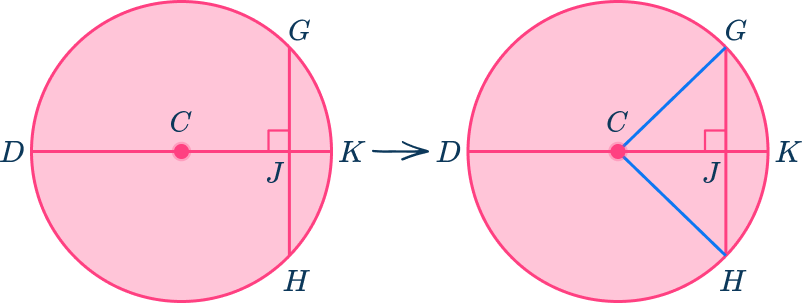
- Thinking that any polygon inside a circle is inscribed
For example, looking at the figures below, the quadrilateral inside circle A is not inscribed because the vertices of the quadrilateral are not all on the edge of the circle.
The quadrilateral in circle B is inscribed because all the vertices are on the edge of the circle.
Practice circle theorems questions
1. In circle B, find the measure of angle ABC.
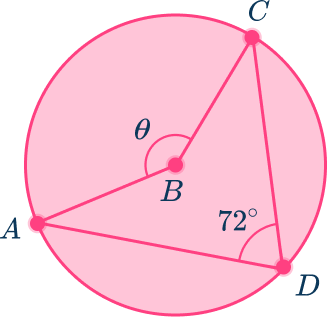




Angle D is an inscribed angle and intercepts arc AC. Inscribed angles are half the measure of the arcs they intercept so arc AC=72 \times 2=144^{\circ}.
Angle ABC is a central angle and the central angle is equal in measure to the arc it intercepts. So, if arc AC is 144^{\circ}, then angle ABC=144^{\circ}.
2. Find the measure of \theta.
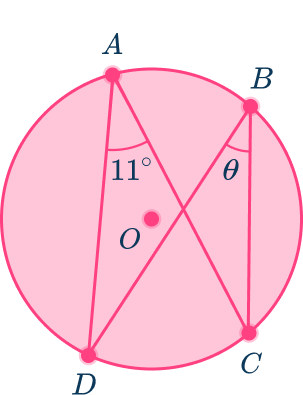




Inscribed angles that intercept the same arc are congruent to each other.
Angle DAC and angle CBD are inscribed angles that both intercept arc CD. This means that angle DAC is equal to angle CBD.
So, if angle DAC=11^{\circ}, then angle CBD=11^{\circ}.
3. Triangle ABC is inscribed in circle D. Find the measure of ϴ.
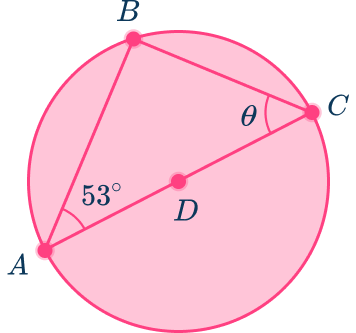




AC is the diameter of circle D and the inscribed angle ABC intercepts semi-circle AC. The semi-circle is 180^{\circ}.
Inscribed angles are half the measure of the arcs they intercept. So, angle ABC=90^{\circ}, angles in a triangle sum to 180^{\circ}.
To find \theta (angle ACB ) =180-(90+53)=37^{\circ}.
4. Quadrilateral ABCD is inscribed in the circle, find the value \theta.
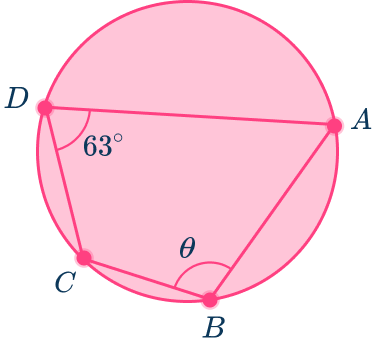




Quadrilaterals inscribed in circles have interior angles where the opposite angles are supplementary (sum to 180^{\circ} ).
In this case, angle D \, + angle B=180^{\circ}, so to find the missing angle, 63^{\circ}+\theta=180^{\circ}, \theta=117^{\circ}.
5. In circle C, \, GH=16 units and CJ=6 units, find the length of the diameter DK.
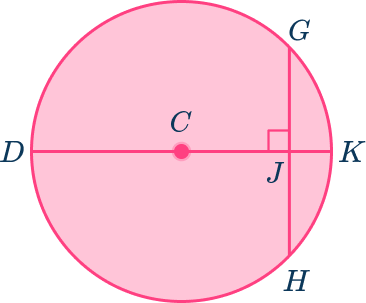
10 units

5 units

20 units

12 units

Since the diameter is perpendicular to chord GH it also bisects chord GH so GJ=JH. \, GH=16 so half of that is 8, \, GJ=8 and JH=8.
Draw in a radius to make a right triangle and use the Pythagorean theorem.
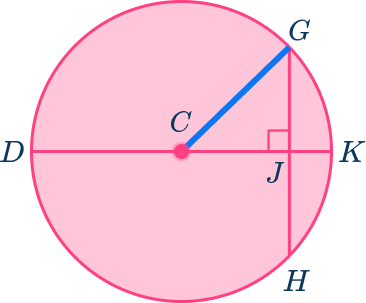
Triangle GJC is a right triangle where sides CJ=6, \, GJ=8 and the hypotenuse is CG (also the radius). Using the Pythagoras’ theorem, 6^2+8^2=c^2, 36+64=c^2, 100=c^2, \mathrm{~c}=10.
Since the radius is equal to 10, the diameter is equal to 2 \times 10=20.
6. Find MP in circle L.
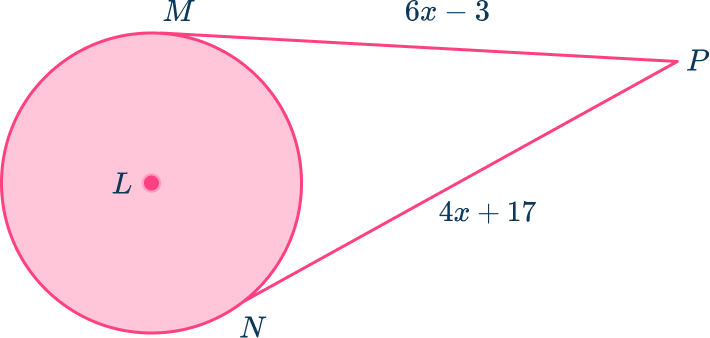




Two lines that are coming from the same external point and are tangent to the same circle are congruent. In this case, MP=NP, so the equation to solve for x is,
\begin{aligned}& 6 x-3=4 x+17 \\\\ & 2 x=20 \\\\ & x=10 \end{aligned}
Substitute the value of x into the algebraic expression that represents MP. \, M P=6 x-3,6(10)-3=57.
Circle theorem FAQs
Arc length is the distance between the two endpoints of an arc. The arc length is part of the circumference of a circle which should not be confused with the measure of an arc.
An arc can have a degree measure because it is a portion of the full 360^{\circ} of a circle and it can also have length.
The alternate segment theorem, is also known as the tangent-chord theorem. It is one of the circle theorems which states that the angle between a chord and a tangent through one of the chord’s endpoints is equal to the angle in the alternate segment of the chord.
The theorem is used to find missing angle and arc measurements. According to the alternate segment theorem, angle AOB is equal to angle ACO. 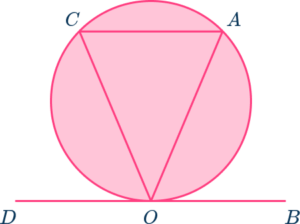
The definition of a circle is a locus of points. This means it is the set of all points that are the same distance from a fixed point. The distance of the set of points from a fixed point is the radius length of a circle and the fixed point is the centre of the circle.
Yes, sometimes with the different circles, you need to use trigonometry to find the size of the angles within the triangle.
See also: Trigonometry
The next lessons are
- Types of data
- Averages and range
- Representing data
Still stuck?
At Third Space Learning, we specialize in helping teachers and school leaders to provide personalized math support for more of their students through high-quality, online one-on-one math tutoring delivered by subject experts.
Each week, our tutors support thousands of students who are at risk of not meeting their grade-level expectations, and help accelerate their progress and boost their confidence.

Find out how we can help your students achieve success with our math tutoring programs.
[FREE] Common Core Practice Tests (3rd to 8th Grade)
Prepare for math tests in your state with these 3rd Grade to 8th Grade practice assessments for Common Core and state equivalents.
Get your 6 multiple choice practice tests with detailed answers to support test prep, created by US math teachers for US math teachers!